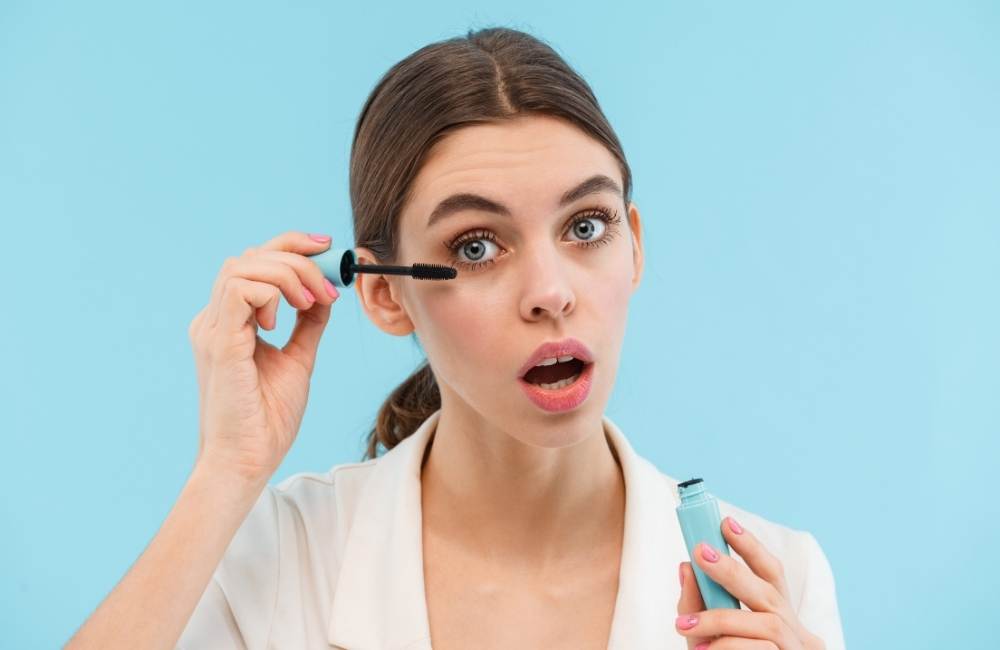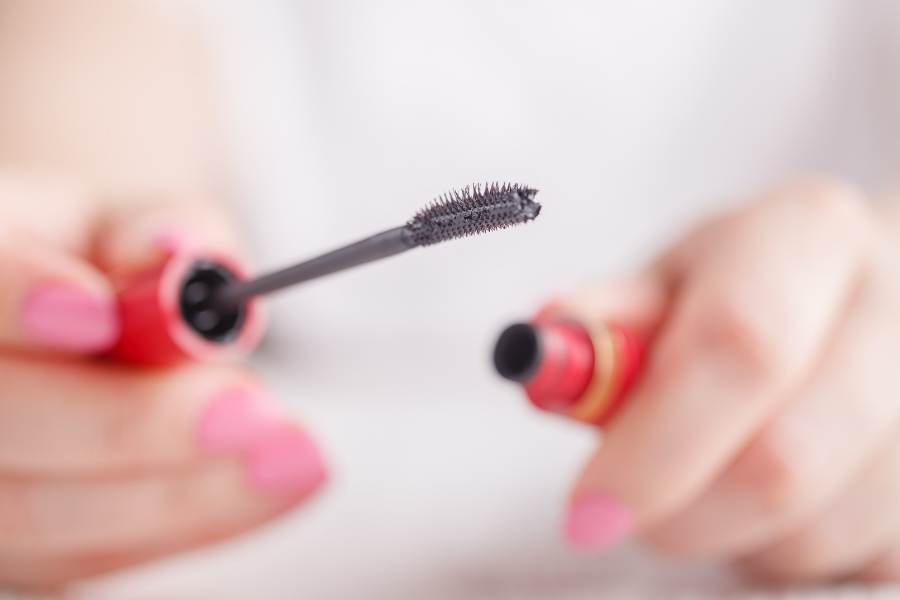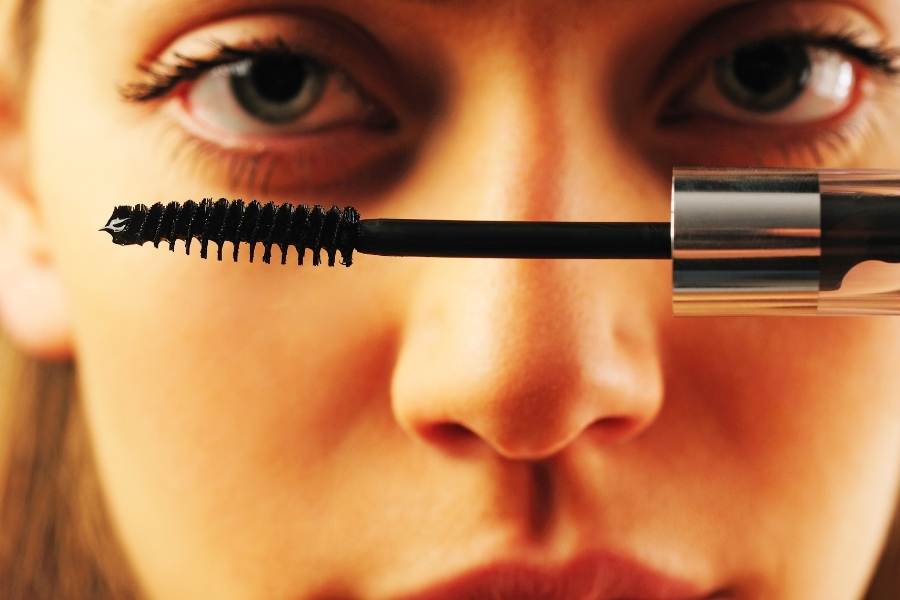Mascara has taken an important place in a makeup lover’s regimen (including mine!). Once you get the hang of using it, it becomes your everyday essential, and you find yourself wondering – is mascara bad for your eyelashes in the long run?
My mascara and I share a love-hate kind of relationship. I love how it lifts up my eyelashes and makes them appear voluminous and thick. But on the other hand, I dread how it might affect my eyes and eyelashes.
So here, we’ll talk about the good, bad, and ugly of mascara and if it is bad to wear mascara every day.

Contents
The Power of Mascara
The right mascara can brighten, widen, and define eyes. Here’s what it does:
- Darkening and thickening lashes
- Lengthening the lash line for a doe-eyed look
- Curling straight lashes upwards
- Emphasizing eyes for a more awakened appearance
- Completes your makeup look. Even on minimal makeup days, a swipe of mascara can make all the difference.
Boosts your confidence. Often, feeling good comes from looking good.
With so many mascara formulas on the market promising big, beautiful lashes, mascara remains a staple.
What’s in a mascara?
- Pigments give mascara its color. Common pigments include carbon black and iron oxides for black and brown mascaras.
- Oils give mascara a smooth and creamy texture while conditioning the lashes. Some of the most used career oils are linseed oil, lanolin, castor oil, and eucalyptus oil.
- Waxes help mascara stay glued to the lashes and make it waterproof. The most used ones are beeswax, lanoline, mineral oil, carnauba wax, and paraffin wax.
- Preservatives Ingredients like preservatives prolong mascara’s shelf life by preventing bacteria from growing, which is bad for your eyes. These include parabens, phenoxyethanol, and sodium dehydroacetate.
- Thickeners like gum Arabic, talc, and silica add thickness and volume to mascara, making it easy for the mascara wand to spread on eyelashes.
- Emulsifiers help mascara’s oil and water components combine to form a stable formula. Stearic acid and polysorbates are typical emulsifiers.
As mascara formulas may differ between brands, check the label if you have specific allergies or sensitivities.
The Negatives
When I started using mascara, I got addicted to it and used it daily. It was a washable mascara but water-resistant, which is a bit less harmful than a waterproof one.
Harmful ingredients
Preservatives like parabens and formaldehyde-releasers may cause irritation or allergic reactions. Mineral oil-based preservatives are gentler alternatives.
Some pigments contain chemicals that may be toxic. Using non-toxic, mineral-based pigments can provide vibrant color without health risks.
While thickeners plump up lashes quickly, they may leave them brittle and prone to breakage over time. It’s a good idea to alternate between thickening and conditioning mascara formulas for fuller lashes with minimal lash damage.
Mascara that is entirely loaded with unregulated chemicals like preservatives, petroleum, fragrance, and colorants can potentially risk skin problems like irritation, itchiness, redness, allergic reactions, and eczema.
Can make your eyelashes fall out
Long-term use of mascara is associated with eyelash fall, according to a study. The cosmetic study also found that using water to remove waterproof mascara can lead to more eyelashes falling out.
Risks injury to your eye
When applying mascara in a rush, you can accidentally poke your eyes with the wand and get a scratched cornea (corneal abrasion) that can make your eyes inflamed and painful for days. The risk increases even more when you’re wearing contact lenses.
Demands extra care for contact lenses
Those who wear contact lenses are prone to mascara damage as they need to be extra careful to maintain eye health. Poor hygiene can lead to eye irritation and possibly an infection, but with proper hygiene, the use of mascara can be safely incorporated. Opt for a mascara that works for sensitive eyes and is ophthalmologically tested and approved.
Harsh removal
Removing it was a real pain. Waterproof formulas tend to cling tenaciously and require stronger makeup removers that could weaken lashes over time. So, I used coconut oil soaked in a cotton pad to remove it. After using mascara regularly for two weeks, I noticed my eyelashes were getting thinner, and what most shocking was they were losing their natural tint. It almost seemed like I had no eyelashes.
What makes a bad mascara?
Your mascara isn’t exactly bad, but its ingredients can be. Harmful ingredients can trigger damage to your eyes.
Let’s take a look at these ingredients:
- Parabens (used to increase shelf-life that mimics estrogen-affecting hormones)
- Propylene glycol (petroleum that may lead to skin and respiratory issues)
- Retinyl acetate, aka vitamin A Acetate (known to cause biochemical or cellular changes in the body)
- Aluminum powder (gives color to mascara, and long-term exposure can impair essential cell and body functions)
- Coal tar dye (used as a colorant and is cancer-causing and toxic to the brain)
- Fragrance, aka parfum (can be irritating to skin and eyes)
- Formaldehydes aka imidazolidinyl urea, DMDM, methenamine, Diazolidinyl urea, and quaternium-15 (cancer-causing agents that may also cause dermatitis) BHT and BHA (preservatives that may disrupt the endocrine system)
- BHT and BHA (preservatives that may disrupt the endocrine)
These ingredients altogether can lead to itchiness, redness, and inflammation around the eyes. Even worse, they can disrupt your hormones and reproductive system.
What should you actually look for?

Making the right choices when purchasing mascara will limit harm in the long run. Before purchasing one, look it up on EWG’s Skin Deep database to check the safety, potential toxicity, and breakdown of ingredients.
A rating of 1 to 2 indicates safety, and 3 to 4 is an average. Anything 5 and above is unsafe and should be avoided.
The key is to find a good, ethical brand of mascara, most preferably cruelty-free and vegan, and stick with it. This also means reconsidering a brand you currently use that isn’t clean.
So, is Mascara That Bad for Your Eyelashes?
The answer lies somewhere between yes and no. Wearing mascara all day and removing it at night can cause some temporary damage, like breakage and drying out, but the damage isn’t generally permanent. Yes, if you do not properly remove your mascara every day and neglect to take care of your lashes, they could suffer.
In other words, you don’t have to worry about mascara being bad for your lashes as long as you take care when applying and removing it.
Also, giving lashes a break by going mascara-free one day per week and treating them to a nourishing serum or oil every so often surely helps.
How to Deal with the Dangers of Mascara
Before getting mascara, I followed a skincare regimen and used castor oil on my eyelashes every night. This made my brows and lashes thicker and longer, but my negligence ruined my efforts.
It wasn’t just my mascara’s fault but mine too, so I figured out my own ways to use mascara and still maintain my lashes. These were the ways that helped me revive my lashes:
- I limited my use of mascara from daily to just every other day. That helps a lot.
- Save your waterproof mascara for special occasions where you need it to stay longer and withstand moisture, but for daily use, choose a strengthening or washable mascara.
- Whatever mascara you own, including the clear ones, ALWAYS take it off with a gentle eye makeup remover or use olive oil or coconut oil to remove it. Remember not to be harsh and take your time to remove gently.
- Follow a proper eye care routine to strengthen and moisturize eyelashes.
- Use an eyelash primer before mascara that wraps lashes in a protective conditioning layer.
- Apply from root to tip and wait until the coat dries before applying another. Don’t keep on coating more and more layers, as it will lead to clumping and serious damage to eyelashes and eyes.
- Don’t forget to look at the ingredients before purchasing the mascara. Avoid these ingredients: Propylene Glycol, Bronopol, Parabens, Aluminum Powder, Retinyl Acetate, Benzyl Alcohol, Triethanolamine.
- Clear mascara is a safer choice. They not only make your eyes look natural but well-groomed and neat, too.
- I used an eyelash comb to brush my eyelashes once or twice a day. It helps lashes to distribute natural oils along the length.
- Occasionally, giving lashes a “break” from mascara 1-2 days a week allows them to recover.
- Look for eyelash serums with peptides, biotin, botanical oils, and ceramides to nourish follicles.
- The dramatic impact of using too much mascara made my lashes thin and almost fall out. After reading up on a lot of reviews, I purchased and tried RevitaLash Advanced Eyelash Conditioner, which claimed to condition, nourish, and grow lashes between 3-10 weeks. After consistent use for a month and a half, I started noticing longer eyelashes, which was surprising for a girl who had sparse eyelashes all her life. I reduced the usage after getting the desired results.
These were the steps I took to avoid more damage to my -lashes. I incorporated all of them, and now my lashes are getting back to their original, healthy form.
Most-asked Questions about Mascara

Here are some frequently asked questions about using mascara that I have tried my best to answer with proper research.
Does mascara damage your eyelashes?
Yes, when you overuse it for touch-ups – especially waterproof ones, as they require more effort while removing. This can result in lashes falling out.
Is clear mascara bad for your eyelashes?
Although it gives a natural and your lashes but better look, clear mascara contains the same ingredients as a colored one, except the colorants aren’t used in it. They may seem invisible but can pose the same threat to lashes.
Is waterproof mascara bad for your lashes?
Waterproof mascara comes with added wax and silicone to it, making it resist sweat, tears, and water. As a result, your lashes lose moisture and dry out. However, you can still combat the effect by taking the time to remove mascara completely but gently.
Does mascara make your eyelashes thinner?
It all boils down to how you mascara – either properly or carelessly. Multiple mascara coats can put a lot of stress on eyelashes, making them appear thin and short. Keep those million coats saved for special occasions.
Is wearing mascara every day bad for your eyelashes?
Using mascara is one thing, and keeping it on your eyelashes all the time is another. Using it every day can make the removal process difficult and cause lashes to break, so no, everyday mascara can ruin your eyelashes.
How often should I replace my mascara?
Rule of thumb: toss your mascara every three months. Bacteria love to hang out in dark, moist environments (like your mascara tube), so using old, expired products can lead to infections that could harm your delicate lashes. Even a study confirms that.
Is mascara good for your eyelashes?
Yes – only when it’s clean and all-natural. Look for formulas that condition, protect, and hydrate lashes. However, these mascaras can be a bit heavy on your pocket, but they’re the best ones you can go for to avoid lash damage.
Bottom line
So, is mascara bad for your eyelashes? The answer is it depends. If you don’t overuse it, maintain a proper eyelash routine, and ensure a quality product with safe (and healthy) ingredients, the mascara won’t play a bad boy in your lashes anymore. Also, make sure you throw it once it expires (mascara has a shelf-life of three months).
Have you experienced any damaging effects of mascara? Share with me in the comments.